After posting on Nasher Sculpture Center’s Sculpture garden–very much a rarefied 1%er’s kind of garden–it’s really comforting to return to the garden I call home. It’s April 15 in this 99%er’s garden, and time for this months Garden Blogger’s Bloom Day meme, hosted of Carol at May Dreams Gardens.
Every time I do one of these posts I worry that I’m showing you the same things. But since I stare at these plants for hours on end I hope you don’t mind the repeat appearances of some of the things that are still blooming. But in addition to the forever bloomers there are a lot of new things starting up this month.
Here’s an overview of the irrigated raised bed. There’s a native coyote bush in the back that I raised from seed, and it seems fine with this somewhat moist location. In front of it are some blooming exotics: a potted Euphorbia lambii with its chartreuse flowers, an Arctotis hybrid “Big Magenta” in the lower left, Salvia microphylla ‘Hot Lips’ to the right and a honey bush (Melianthus major) in the background, right, with its dark red bracts.
Euphorbia lambii detail.
There’s a lot from California (or very nearby) in bloom:
Verbena lilacina (from nearby in Mexico)
Blue-eyed grass (Sisyrinchium bellum) livening up the edges of the veggie plantings.
Some of the last flowers on the black sage, Salvia mellifera.
Takes 1-3 of Salvia clevelandii ‘Winnifred Gilman.”
A red monkeyflower seedling from a cultivar that died a couple of years ago.
The local stinging lupine, Lupinus hirsutissimus.
The local coastal sea daisy, previously called a coreopsis, I’m trying to get used to its new name, Leptosyne maritima.
Another ex-coreopsis, Leptosyne gigantea.
The local bladderpod, Isomeris arborea, with one of its bladder-like seedpods to the right.
Island alum root doesn’t so incredibly well for me. I suspect that I’m not watering it enough to make it bloom like mad like I’ve seen it do locally.
A fremontia that we have in East County, Fremontodendron mexicanum. It’s a plant that’s been imprisoned in a gallon pot from a plant sale last fall, waiting until I figure out where to put a really big plant.
The giant island buckwheat (Eriogonum giganteum) in bud. Last year the gophers got to it. I thought it was doomed. Looks like it’s pulling through.
San Miguel Island buckwheat (Eriogonum arborescens).
A succulent dudleya that you find out in the eastern parts of the county, Dudleya saxosa ssp. aloides.
Carpenteria california, in bloom since December.
The California poppies started up last month. They’re close to peaking.
This plant, a spreading form of chamise (Adenostoma fasciculatum) known as ‘Nicholas.”
And from other places we have:
Verbena bonariensis.
An unknown red aloe or aloe hybrid.
Three takes on santolina, S. chamaecyparissus, more in bloom than last month.
The rose geranium in the herb garden is a total monster. Pretty in lavender-pink, though. And it’s pretty easy to pull up.
Yah, yah, yah, this protea all over again…
You’re witness to the final moments of this Mexican evening primrose. It’s a noxious weed in the garden, and I pulled it up five seconds after I put down the camera.
Nile, oblivious to all my weeding and survey work in the garden.
Another weedy plant, Homeria collina. Not nearly as bad as the previous one, so it usually gets to live and reproduce in my garden unless it comes up in a seriously bad spot.
Fortnight iris, Dietes iridioides. Another pretty but really weedy plant. It’s still coming up from seed left by plants a decade ago. This is a flower on the one plant that gets to live.
A couple of takes on blooming graptopetalums.
Silver jade, Crassula argentea, just coming into bloom.
But of the exotics, the most splashy right now are the American pitcher plants, the sarracenia. These carnivorous plants have leaves modified into the bug-catching tubes that are often mistaken for flowers. But you’ll see the floppy mop-top flowers that these guys produce.
S. alata and flowers.
A natural hybrid, S. ‘Leah Wilkerson,” flowers and new pitcher.
A hybrid of S. flava by S. oreophila. The pitchers are just opening, and will turn a much more intense combination of red and yellow.
Happy Bloomday, every’all. For more gardens check out Carol’s April 2012 Bloomday post [ right here ].

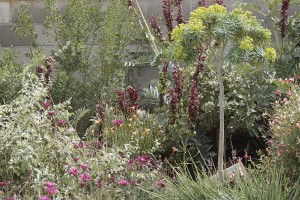



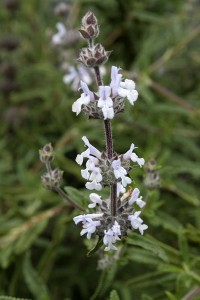

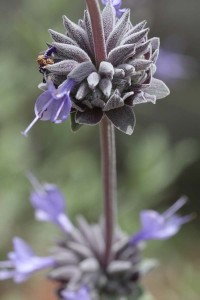
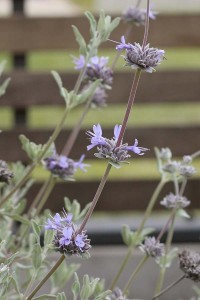
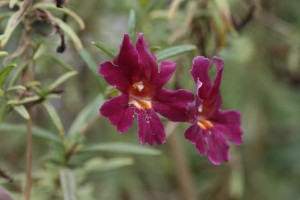
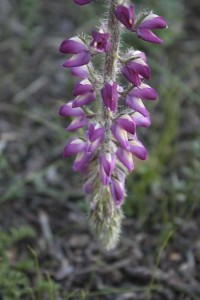
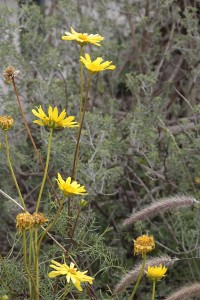
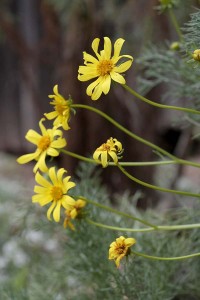

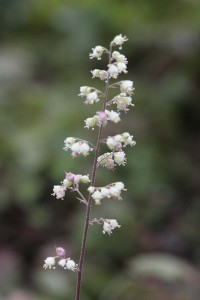
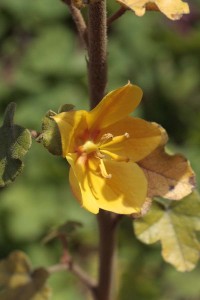


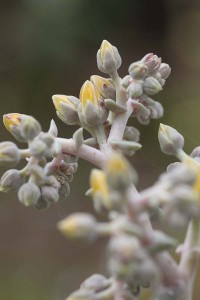

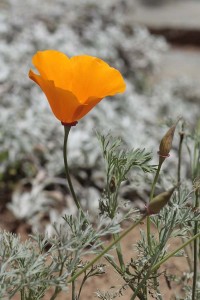
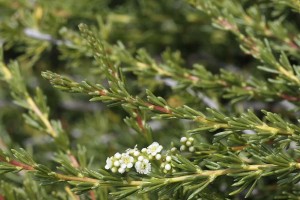
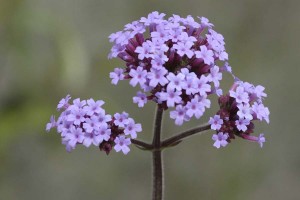
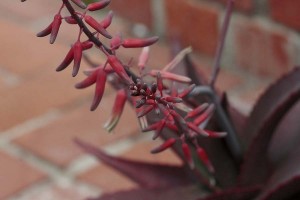
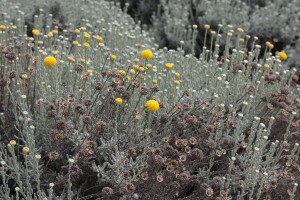
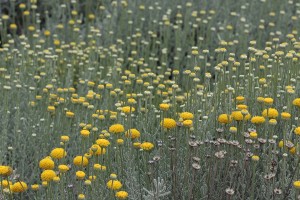
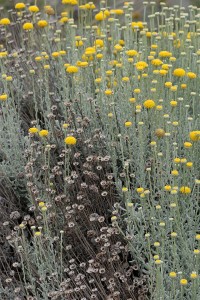




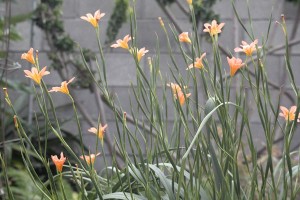
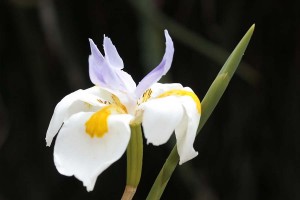




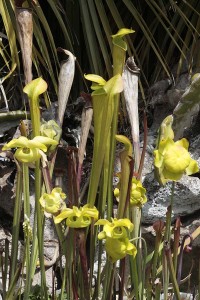
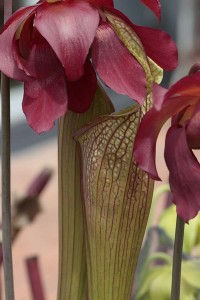

Wow, are your pitcher plants growing in the ground? They are fantastic.
Gorgeous blooms!
Love the pitcher plant shots. Wish I could grow those in 5b/6a Nova Scotia, Canada. We can manage S. purpurea, which is native, and that’s all. Your varieties would have to stay indoors for our winter.
I adore native plants and I love your assortment.
Your ex-Coreopsis looks very much like our Euryops. The same large yellow daisy starring appearance. Fortnight iris? It is also a walking iris ;~)
That seems like a very summer-looking collection of blooms. I know that some of them, the sisyrinchium, beach coreopsis and so forth are spring bloomers up here too, but it’s a sun-washed palette. Maybe the gray weather we’re having up here makes it seem that way, maybe it’s that our salvia’s have greener foliage still from the recent rains. It’s nice to see though, makes me ready for a summer vacation somewhere sage-y.
Did you just say Carpenteria blooming since December? Oh that’s just incredible. If I get a month, I’m very happy. Well, it’s not locally native, and it shows. As for the Heuchera, maybe it would like more shade? Mine are OK with being dry, but insist on part-shade to mostly shade.
Happy bloom day. Isn’t it fun to be back home in the garden!
Fascinating assortment. I feel the same say about some of my regular bloomers – yes, and here’s hummingbird sage – again! I enjoyed the trip through your garden. My fremontodendron is finally taking off after growing s l o w l y for about three years – I love it. I’m not sure how large it is destined to be though! My St Catherine’s lace pegged out this year – just up and died. Guess they don’t live so long, but stunning while they do. Your Winifred G. is way ahead of mine – in fact mine isn’t looking so great in its second year – maybe I pruned it back a bit hard? Or the weird weather? – anyway – thanks for sharing your blooms. I’m going to post mine tonight/tomorrow morning depending.
I thought S. ‘Winifred Gilman’ was a dark blue cultivar, that photo looks more like S. ‘Allen Chickering’. 🙂
wow, new plants to me in Kansas. Nice collection.
Missy, almost in the ground… They’re in “bog buckets,” plastic tubs that have been sunk to soil level and then filled with the pitcher plants and the wet potting mix they require.
Cindy, thanks!
Jeffrey, there’s a grower in zone 6b New York who does a blog on pitcher plants that he grows in zone 6b. I wonder if some of his successes in a somewhat warmer zone than yours might work for you.
Mary, the natives are amazing this time of year!
EE, I’d never heard of the walking iris name! Pretty wild how the same plant accrues so many interesting names.
Ryan, the grayer-leaved sages are our superstars right now. They might say “summer” to you in the Bay Area but here they’re signals of high spring. Interesting how the miles can effect a climate so much.
TM, yes, December. The more established the Carpenteria gets the more it blooms. It must like it’s fairly shady spot, and maybe the neighbor’s over-watering their concrete gives it a little more moisture than my near-desert ways of watering.
CM, you’re so right about the hummingbird sage. I think mine–which is still in bloom–didn’t make it into this month’s album, though it was in last month’s. I’ve been sparing the clippers a little too much with the Winnifred G and it’s quite the monstrous pile of flowers and sage fumes. That might be helping it along. It really is one of the last things to bloom in the spring.
Dustin, I’ve seen Winnifred Gilman described as a blue sage, but the plants I’ve seen of it tend to cluster around lilac or mauve or violet. Someone has mentioned that it’s a plant that gets mis-labeled a lot.
Greggo, thanks!. I’m definitely not in Kansas, here in San Diego…
Some awesome looking blooms, James! Are you actually growing stinging lupine in your garden? It’s a beauty, but not something you’d ever want to run your fingers through. I’ve only run across it in the wilds a couple times – once at Cuyamaca SP and another time in the lower Arroyo Seco in the SG Mountains. Your memento mori on the Mexican primrose just made me lol!
Good luck finding a spot for that Fremontia – they’re so beautiful but also humongous! The eclecticism of your plant collection seems to be on full display this month, with an incredibly alien-looking Euphorbia followed by a bunch of fairly local natives, and the desert-adapted succulents followed by wetland pitcher plants. Where else but here would I see a Fremontia, a Protea, and pitcher plants in a single blog post? It almost looks as if you’ve planted an entire botanical garden.
Impressive…you can show your 1%er garden over and over, and I won’t object. There is a tree-like Fremontodendron in town that was planted at least 20 years ago…an ex-Palm Springs resident said it is F. Californicum. Probably already missed it’s bloom, again…
Protea…oh my! Almost as nice to me as a happy manzanita or madrone.
Whoops, make that your 99%er garden, not “1%er garden”!!!
I’ve had that feeling of repeating myself too, but as you point out: if we never tire of our own blooms, why should others? I know I never tire of yours.
Arleen, I planted seeds of the stinging lupine maybe three years ago, and it’s come back ever since. Once the plant dries out it’s definitely one for the gloves. But pretty tho!
Gayle, can you say “attention deficit disorder?” Or maybe I’ll flatter myself and say I’m just curious. As much as I’m attracted to natives there are always other interesting plants that catch my attention.
David, thanks! I know I wouldn’t grow the protea if it didn’t bloom, but the madrones or manzanitas you mention would keep me happy with their great shapes and amazing bark, flowers or no. As far as the 99 vs 1% garden, I just did my taxes; mine is definitely not a 1%’er’s garden.
Ricki, I’m glad you’ve enjoyed the repeat offenders in the garden. I guess I might be a little harsh on them just because they were blooming X months ago… Maybe I’m ADD after all.